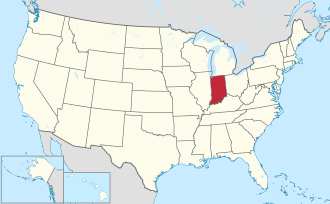History
The area was inhabited for thousands of years by cultures of indigenous peoples. French explorers and traders encountered the historical Miami Native Americans beginning in the 17th century.
Wabash County, along with Delaware County, was originally formed Jan. 1820 out of the 1818 New Purchase resulting from the Treaty of St. Mary's. Wabash County was the Wabash River drainage area, and Delaware County, the White River drainage area. Numerous counties were carved out of the Wabash New Purchase. Wabash County as it exists today was organized out of a remnant portion of the original county in 1835.
The name "Wabash" is an English spelling of the earlier French name for the river, Ouabache. French traders derived the French version from the Indian name for the river, Wabashike (pronounced "Wah-bah-she-keh") (meaning "pure white".) Much of the river bottom is white limestone, now obscured by mud.
Government
The county government is a constitutional body, and is granted specific powers by the Constitution of Indiana, and by the Indiana Code.
County Council: The county council is the legislative branch of the county government and controls all the spending and revenue collection in the county. Representatives are elected from county districts. The council members serve four-year terms. They are responsible for setting salaries, the annual budget, and special spending. The council also has limited authority to impose local taxes, in the form of an income and property tax that is subject to state level approval, excise taxes, and service taxes. [5] [6]
Board of Commissioners: The executive body of the county is made of a board of commissioners. The commissioners are elected county-wide, in staggered terms, and each serves a four-year term. One of the commissioners, typically the most senior, serves as president. The commissioners are charged with executing the acts legislated by the council, collecting revenue, and managing the day-to-day functions of the county government. [5] [6]
Court: The county maintains a small claims court that can handle some civil cases. The judge on the court is elected to a term of four years and must be a member of the Indiana Bar Association. The judge is assisted by a constable who is also elected to a four-year term. In some cases, court decisions can be appealed to the state level circuit court. [6]
County Officials: The county has several other elected offices, including sheriff, assessor, prosecutor, coroner, auditor, treasurer, recorder, surveyor, and circuit court clerk. Each of these elected officers serves a term of four years and oversees a different part of county government. Members elected to county government positions are required to declare party affiliations and to be residents of the county. [6]
Wabash County is a Republican stronghold in presidential elections. Since 1888, only two Republican Party candidates have lost the county, William Howard Taft in 1912 & Barry Goldwater in 1964.
Demographics
Historical population| Census | Pop. | Note | %± |
|---|
| 1840 | 2,756 | | — |
|---|
| 1850 | 12,138 | | 340.4% |
|---|
| 1860 | 17,547 | | 44.6% |
|---|
| 1870 | 21,305 | | 21.4% |
|---|
| 1880 | 25,241 | | 18.5% |
|---|
| 1890 | 27,126 | | 7.5% |
|---|
| 1900 | 28,235 | | 4.1% |
|---|
| 1910 | 26,926 | | −4.6% |
|---|
| 1920 | 27,231 | | 1.1% |
|---|
| 1930 | 25,170 | | −7.6% |
|---|
| 1940 | 26,601 | | 5.7% |
|---|
| 1950 | 29,047 | | 9.2% |
|---|
| 1960 | 32,605 | | 12.2% |
|---|
| 1970 | 35,553 | | 9.0% |
|---|
| 1980 | 36,640 | | 3.1% |
|---|
| 1990 | 35,069 | | −4.3% |
|---|
| 2000 | 34,960 | | −0.3% |
|---|
| 2010 | 32,888 | | −5.9% |
|---|
| 2020 | 30,976 | | −5.8% |
|---|
| 2023 (est.) | 30,670 | [8] | −1.0% |
|---|
|
As of the 2010 United States census, there were 32,888 people, 12,777 households, and 8,733 families residing in the county. [13] The population density was 79.7 inhabitants per square mile (30.8/km2). There were 14,171 housing units at an average density of 34.4 per square mile (13.3/km2). [3] The racial makeup of the county was 96.6% white, 0.7% American Indian, 0.5% black or African American, 0.4% Asian, 0.7% from other races, and 1.1% from two or more races. Those of Hispanic or Latino origin made up 2.1% of the population. [13] In terms of ancestry, 31.3% were German, 18.1% were American, 10.1% were English, and 10.0% were Irish. [14]
Of the 12,777 households, 29.9% had children under the age of 18 living with them, 54.4% were married couples living together, 9.5% had a female householder with no husband present, 31.7% were non-families, and 27.3% of all households were made up of individuals. The average household size was 2.43 and the average family size was 2.92. The median age was 41.2 years. [13]
The median income for a household in the county was $47,697 and the median income for a family was $52,758. Males had a median income of $41,965 versus $26,944 for females. The per capita income for the county was $20,475. About 8.8% of families and 11.6% of the population were below the poverty line, including 15.5% of those under age 18 and 8.1% of those age 65 or over. [15]
This page is based on this
Wikipedia article Text is available under the
CC BY-SA 4.0 license; additional terms may apply.
Images, videos and audio are available under their respective licenses.




